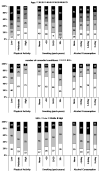Relative contributions of modifiable risk factors to erectile dysfunction: results from the Boston Area Community Health (BACH) Survey
- PMID: 19944117
- PMCID: PMC2813912
- DOI: 10.1016/j.ypmed.2009.11.006
Relative contributions of modifiable risk factors to erectile dysfunction: results from the Boston Area Community Health (BACH) Survey
Abstract
Objectives: The objective of this study was to determine the relative contribution of modifiable risk factors (physical activity, smoking, and alcohol consumption) to inter-subject variation in erectile dysfunction (ED).
Methods: The Boston Area Community Health (BACH) Survey used a multistage stratified random sample to recruit 2301 men age 30-79 years from the city of Boston between 2002 and 2005. ED was assessed using the 5-item International Index of Erectile Function (IIEF-5). Multiple linear regression models and R(2) were used to determine the proportion of the variance explained by modifiable risk factors.
Results: In unadjusted analyses, lifestyle factors accounted for 12.2% of the inter-subject variability in IIEF-5 scores, comparable to the proportion explained by comorbid conditions (14.7%) and socioeconomic status (9%). Lifestyle factors were also significantly associated with age, comorbid conditions and socioeconomic status (SES). A multivariate model including all covariates associated with ED explained 29% of the variance, with lifestyle factors accounting for 0.9% over and above all other covariates in the model. Analyses repeated in a subgroup of 1215 men without comorbid conditions show lifestyle factors accounting for 2.5% of the variance after accounting for all other variables in the model.
Conclusions: Results of the present study demonstrate the contribution of modifiable lifestyle factors to the prevalence of ED. These results suggest a role for behavior modification in the prevention of ED.
Copyright 2009. Published by Elsevier Inc.
Figures


Comment in
-
About validity of conclusions based on multiple linear regression: a commentary on Kupelian et al. (2010).Prev Med. 2011 Jun;52(6):465; author reply 466-7. doi: 10.1016/j.ypmed.2011.01.013. Epub 2011 Feb 2. Prev Med. 2011. PMID: 21295060 No abstract available.
Similar articles
-
Socioeconomic status, not race/ethnicity, contributes to variation in the prevalence of erectile dysfunction: results from the Boston Area Community Health (BACH) Survey.J Sex Med. 2008 Jun;5(6):1325-33. doi: 10.1111/j.1743-6109.2008.00822.x. Epub 2008 Apr 10. J Sex Med. 2008. PMID: 18410305
-
Common prescription medication use and erectile dysfunction: results from the Boston Area Community Health (BACH) survey.BJU Int. 2013 Dec;112(8):1178-87. doi: 10.1111/bju.12231. Epub 2013 Jul 2. BJU Int. 2013. PMID: 23819576 Free PMC article.
-
Changes in erectile dysfunction over time in relation to Framingham cardiovascular risk in the Boston Area Community Health (BACH) Survey.J Sex Med. 2015 Jan;12(1):100-8. doi: 10.1111/jsm.12715. Epub 2014 Oct 8. J Sex Med. 2015. PMID: 25293632 Free PMC article.
-
Modifying risk factors to prevent and treat erectile dysfunction.J Sex Med. 2013 Jan;10(1):115-9. doi: 10.1111/j.1743-6109.2012.02816.x. Epub 2012 Sep 12. J Sex Med. 2013. PMID: 22971247 Review.
-
The effect of lifestyle modification and cardiovascular risk factor reduction on erectile dysfunction: a systematic review and meta-analysis.Arch Intern Med. 2011 Nov 14;171(20):1797-803. doi: 10.1001/archinternmed.2011.440. Epub 2011 Sep 12. Arch Intern Med. 2011. PMID: 21911624
Cited by
-
Can lifestyle modification affect men's erectile function?Transl Androl Urol. 2016 Apr;5(2):187-94. doi: 10.21037/tau.2016.02.05. Transl Androl Urol. 2016. PMID: 27141445 Free PMC article. Review.
-
Cohort profile: the Boston Area Community Health (BACH) survey.Int J Epidemiol. 2014 Feb;43(1):42-51. doi: 10.1093/ije/dys198. Epub 2012 Dec 5. Int J Epidemiol. 2014. PMID: 23220718 Free PMC article.
-
A randomized, double-blind, placebo-controlled crossover study of Cappra® for the treatment of mild or mild to moderate erectile dysfunction in Thai male.Afr J Tradit Complement Altern Med. 2012 Dec 31;10(2):310-5. eCollection 2013. Afr J Tradit Complement Altern Med. 2012. PMID: 24146455 Free PMC article. Clinical Trial.
-
Relationship between age and erectile dysfunction diagnosis or treatment using real-world observational data in the USA.Int J Clin Pract. 2016 Dec;70(12):1012-1018. doi: 10.1111/ijcp.12908. Int J Clin Pract. 2016. PMID: 28032424 Free PMC article.
-
Substance use disorders in men presenting to a psychosexual clinic.ISRN Addict. 2014 Jan 6;2014:486383. doi: 10.1155/2014/486383. eCollection 2014. ISRN Addict. 2014. PMID: 25938122 Free PMC article.
References
-
- Bacon CG, Mittleman MA, Kawachi I, Giovannucci E, Glasser DB, Rimm EB. Sexual function in men older than 50 years of age: results from the health professionals follow-up study. Ann Intern Med. 2003;139:161–8. - PubMed
-
- Bacon CG, Mittleman MA, Kawachi I, Giovannucci E, Glasser DB, Rimm EB. A prospective study of risk factors for erectile dysfunction. J Urol. 2006;176:217–21. - PubMed
-
- Bergmann MM, Byers T, Freedman DS, Mokdad A. Validity of self-reported diagnoses leading to hospitalization: a comparison of self-reports with hospital records in a prospective study of American adults. Am J Epidemiol. 1998;147:969–77. - PubMed
-
- Blanker MH, Bohnen AM, Groeneveld FP, Bernsen RM, Prins A, Thomas S, Bosch JL. Correlates for erectile and ejaculatory dysfunction in older Dutch men: a community-based study. J Am Geriatr Soc. 2001;49:436–42. - PubMed
Publication types
MeSH terms
Grants and funding
LinkOut - more resources
Full Text Sources
Medical
Miscellaneous

